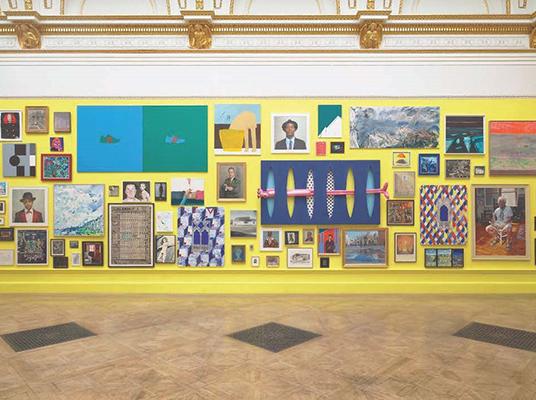
The focus of this presentation was Dr. Turner’s exhibition and online publication, created, as the title suggests, for the 250th anniversary of the Royal Academy’s annual Summer Exhibition. Working with 90 collaborators, the online publication allows readers to revisit each year of the exhibition, starting in 1769. In each entry, online visitors can view the catalogue, scroll through visualizations of statistics (for example, medium of exhibitors), or see who was on the selection committee for that year.
In the third and final installment of the Rethinking the Global Turn series, Dr. Sarah Victoria Turner, Deputy Director of Research for the Paul Mellon Centre for Studies in British Art at Yale University, and founding co-editor of British Art Studies, presented on the theme of digital art histories. The series, organized by the Division of Art History as a part of the Simpson Center’s Next Generation PhD initiative, has included a number of public lectures and workshops that have been dedicated to an examination of emerging art historical methodologies from the archaeological to the oceanic.
While Dr. Turner’s sessions focused on new digital tools for art history, she reinforced that the digital and the analog need not be seen as discrete or opposing approaches. Indeed, several of the questions at both events had to do with the stakes of academic publishing more broadly, from peer review to audience engagement.
On Thursday, Dr. Turner presented a public lecture, “Exhibition Histories, Digital Futures: Researching, Curating, and Publishing 250 Years of the Royal Academy’s Summer Exhibition.” The focus of this presentation was Dr. Turner’s exhibition and online publication, created, as the title suggests, for the 250th anniversary of the Royal Academy’s annual Summer Exhibition. Working with 90 collaborators, the online publication allows readers to revisit each year of the exhibition, starting in 1769. In each entry, online visitors can view the catalogue, scroll through visualizations of statistics (for example, medium of exhibitors), or see who was on the selection committee for that year.
In reflecting on the project during her presentation and in the following Q&A, Dr. Turner explained how one of the challenges she and her co-authors faced was writing for an academic publication while being limited to 1,000-word entries. Yet in doing so, the publication presents a range of digestible articles. Although the data set that the team worked with was fairly comprehensive, the result is not a textbook but more a set of glimpses into exhibitions past. In presenting these histories of exhibitions, Dr. Turner explained, we might better understand the ways in which institutions shape artistic production.
In the same Q&A session, Dr. Turner recounted a question she had received multiple times from readers: would they publish a print version of the chronicle? “You’ve completely missed the point,” she recalls thinking in response. Not to disregard the role of print publications, Dr. Turner suggested that the online chronicle was not simply the digital version of a print catalogue. In doing so, she proposed that the power of these digital tools is not simply that they digitize, but rather that they can ask new questions and present new ways of thinking about old questions.
This had resonance with advice given by Professor Nancy Um of Binghamton University, the first visitor in the Rethinking the Global Turn series. While Professor Um’s lecture was organized around the idea of an oceanic approach to art history, she also led a workshop, “Data Visualization for Art Historians and Historians.” As an introduction to a hands-on session with data visualization software, Professor Um reminded workshop participants that just because you can make detailed plots and tables with your data, doesn’t mean that you always should. In other words, scholars must continue to question how new methodologies contribute (or detract) from their arguments. Similarly, Dr. Turner, at the end of the Q&A session reminded us that although she has found useful applications for digital tools in her work, she is not a “tech evangelist.”
Regardless, the next morning an eager group of student and faculty, as well as representatives from the UW Libraries and UW Press showed up for Dr. Turner’s workshop, “Online Publishing Now.” The session built off the previous night’s lecture and oscillated between discussions of big-picture issues in academic publishing to nitty-gritty details like Creative Commons licensing. In addition, Dr. Turner gave advice to the workshop participants on topics such as developing a strong working relationship with publishers and which tools might be most appropriate for specific projects.
While for some, conversations under the umbrella of a topic as broad as “digital” can sometimes feel as overly technical as they can apocalyptic, Dr. Turner’s visit was a refreshing reminder that the digital turn does not necessitate an abandonment of all wisdom and conventions of the analog. Rather, her presentation suggested continuity as well as innovation, and provided an encouraging way of thinking about the new directions for digital art histories.